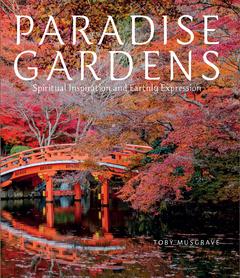
The title of Paradise Gardens is a little misleading if like me you assumed it was another coffee table book that would be full of large glossy pictures of gardens with some text alongside. Instead this book has a completely different feel. Although its appearance is of your typical occupant of the coffee table glamour pack when you open it you realize that you are expected to actually engage with the text and as Hercule Poirot would say “exercise your little gray cells”.
Dr Toby Musgrave, demonstrates his academic credentials in this book which brings together the majority of religions and spiritual belief systems in the world, now and past. The premise of the book is to explore how these beliefs systems draw on nature and in some cases how this then goes on to influence the creation of gardens.
We start with the classical and ancient belief systems: Egypt, Minoan, Mesopotamia, Greece and Rome. Each paragraph discusses the basic history of the culture and most importantly how they overlapped demonstrating that the idea that these cultures existed in isolation to be inaccurate. Musgrave discusses how the overlapping cultures through trade and conflicts shared their beliefs influencing each other. This is also very clear in the sections on Eastern religions (Confucianism, Taoism, Buddhism, Scholar Gardens, Japan, Zen). A particularly long section with an abundance of glorious pictures of magical Eastern temples and gardens.
There is also a substantive section on Abrahamic religion which covers the Garden of Eden, medieval gardens, Islam, Renaissance, and ‘Elysium rediscovered’. For me the last two was disconnected to the theme of the book. I felt as though the book had strayed into a more landscape history book rather than focussing on religion and spiritual influences. The Elysium section refers to the 18th century landscape movement in England and although the text refers back to the Greece and Roman influences I felt it was a detour. I was also disappointed that symbolism, particularly in Islamic gardens, wasn’t given more room; having been to a talk this week on just this subject I know it is fascinating.
The final section on Pantheism and polytheism (I told you that you needed to engage your brain) covers Hindiusm, Northern Paganism, Evergreens, North America and Mesoamerica and New Beliefs. However, there is no reference in book to the faiths and beliefs associated with the Aborigines, Maori, and people of Africa which seems a significant oversight.
Paradise Gardens is informative and full of not only beautiful images of landscapes and gardens but fascinating objects and art. There are a number of discreet articles on specific gardens around the world which exemplify a particular faith or belief. I found the one on The Cloisters Museum in New York, built in the 1930s intriguing; the pictures show the garden to be skilfully planted and constructed and you can almost imagine a monk sitting and contemplating. Ryoan-ji Temple in Kyoto, Japan shows it to be quite exceptional – truly a place to aspire to visit.
Paradise Gardens is a book to dip into as and when and I am sure you will find many new and fascinating insights.

